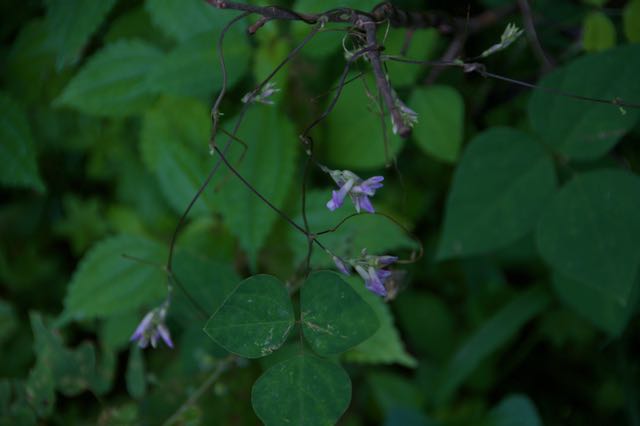pointedleaf ticktrefoil

Desmodium glutinosum
Description:
Pointedleaf ticktrefoil (Desmodium glutinosum) is a herbaceous perennial plant native to North America. Below is a breakdown of its morphology and ecology:
Morphology (Physical Characteristics)
- Leaves:
- Compound with three leaflets (trifoliate).
- The leaflets are ovate to lance-shaped with pointed tips, giving the plant its common name.
- Upper leaf surface is usually smooth or slightly rough, while the underside can be more hairy.
- Height:
- Grows between 1 to 3 feet (30–90 cm) tall.
- Flowers:
- Small, pea-like flowers in light pink to purple shades.
- Blooms in mid to late summer (July through September).
- Flowers are arranged in racemes along the upper part of the stem.
- Fruit:
- Produces flat, segmented pods (loments) that break apart easily.
- Each segment contains a single seed and is covered in tiny hooked hairs, helping it attach to animals (a mechanism known as epizoochory).
- Stems:
- The stems are sticky or covered with glandular hairs, giving the plant a “glutinous” feel (which aligns with its species name, glutinosum).
Ecology (Habitat and Role in Ecosystem)
- Habitat:
- Found primarily in woodlands, forests, and shady clearings, especially in rich, moist soils.
- Thrives in both deciduous forests and along forest edges, preferring partial to full shade.
- Distribution:
- Native to the eastern and central United States and parts of southeastern Canada.
- Pollination:
- Pollinated by a variety of insects, particularly bees that are attracted to the nectar and flowers.
- Seed Dispersal:
- The plant uses epizoochory (dispersal by attaching to animal fur or human clothing) to spread its seeds.
- Ecological Role:
- Nitrogen fixation: Like other legumes, pointedleaf ticktrefoil forms symbiotic relationships with nitrogen-fixing bacteria, improving soil fertility.
- Wildlife support: Provides food and habitat for bees and other insects. The seeds are consumed by some small mammals and birds.
- Adaptations:
- Sticky pods aid in seed dispersal, increasing the plant’s reach.
- Tolerance for low-light conditions allows it to thrive under forest canopies where competition for light is high.
This plant plays a key role in forest ecosystems by contributing to soil health and supporting insect populations.
Details:
pointedleaf ticktrefoil
[wi_plants_standard_vw filter="attr::emd_usda_symbol::is:: DEGL5;"]
[wip_eco_standard_vw filter="attr::emd_usda_symbol::is:: DEGL5;"]
[wip_legal_standard_vw filter="attr::emd_usda_symbol::is:: DEGL5;"]
[wip_morph_standard_vw filter="attr::emd_usda_symbol::is:: DEGL5;"]
[wip_require_standard_vw filter="attr::emd_usda_symbol::is:: DEGL5;"]
[wip_repro_standard_vw filter="attr::emd_usda_symbol::is:: DEGL5;"]
[wip_use_standard_vw filter="attr::emd_usda_symbol::is:: DEGL5;"]
References:
- Integrated Taxonomic Information System – Amphicarpaea bracteata
- USDA Plants Database – Amphicarpaea bracteata
- WisFlora Database – Amphicarpaea bracteata
